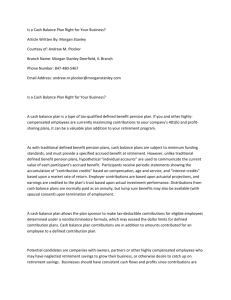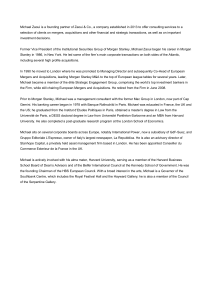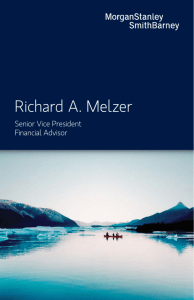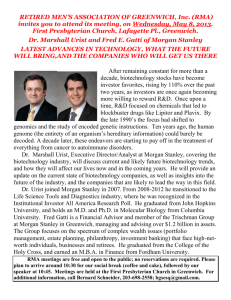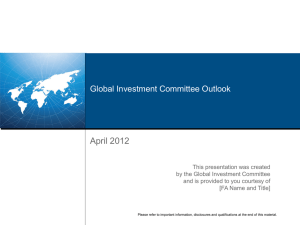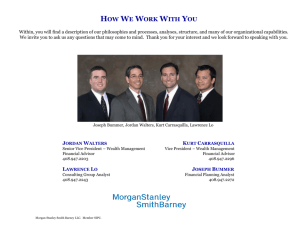The attached letter has been approved for client viewing and can be
advertisement
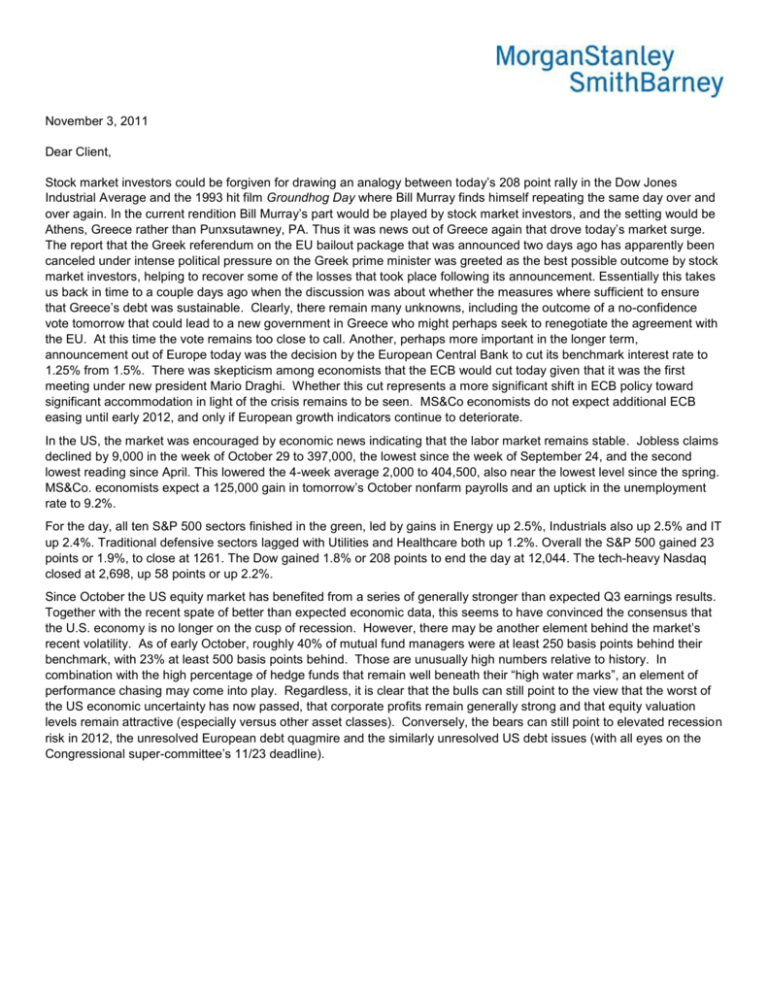
November 3, 2011 Dear Client, Stock market investors could be forgiven for drawing an analogy between today’s 208 point rally in the Dow Jones Industrial Average and the 1993 hit film Groundhog Day where Bill Murray finds himself repeating the same day over and over again. In the current rendition Bill Murray’s part would be played by stock market investors, and the setting would be Athens, Greece rather than Punxsutawney, PA. Thus it was news out of Greece again that drove today’s market surge. The report that the Greek referendum on the EU bailout package that was announced two days ago has apparently been canceled under intense political pressure on the Greek prime minister was greeted as the best possible outcome by stock market investors, helping to recover some of the losses that took place following its announcement. Essentially this takes us back in time to a couple days ago when the discussion was about whether the measures where sufficient to ensure that Greece’s debt was sustainable. Clearly, there remain many unknowns, including the outcome of a no-confidence vote tomorrow that could lead to a new government in Greece who might perhaps seek to renegotiate the agreement with the EU. At this time the vote remains too close to call. Another, perhaps more important in the longer term, announcement out of Europe today was the decision by the European Central Bank to cut its benchmark interest rate to 1.25% from 1.5%. There was skepticism among economists that the ECB would cut today given that it was the first meeting under new president Mario Draghi. Whether this cut represents a more significant shift in ECB policy toward significant accommodation in light of the crisis remains to be seen. MS&Co economists do not expect additional ECB easing until early 2012, and only if European growth indicators continue to deteriorate. In the US, the market was encouraged by economic news indicating that the labor market remains stable. Jobless claims declined by 9,000 in the week of October 29 to 397,000, the lowest since the week of September 24, and the second lowest reading since April. This lowered the 4-week average 2,000 to 404,500, also near the lowest level since the spring. MS&Co. economists expect a 125,000 gain in tomorrow’s October nonfarm payrolls and an uptick in the unemployment rate to 9.2%. For the day, all ten S&P 500 sectors finished in the green, led by gains in Energy up 2.5%, Industrials also up 2.5% and IT up 2.4%. Traditional defensive sectors lagged with Utilities and Healthcare both up 1.2%. Overall the S&P 500 gained 23 points or 1.9%, to close at 1261. The Dow gained 1.8% or 208 points to end the day at 12,044. The tech-heavy Nasdaq closed at 2,698, up 58 points or up 2.2%. Since October the US equity market has benefited from a series of generally stronger than expected Q3 earnings results. Together with the recent spate of better than expected economic data, this seems to have convinced the consensus that the U.S. economy is no longer on the cusp of recession. However, there may be another element behind the market’s recent volatility. As of early October, roughly 40% of mutual fund managers were at least 250 basis points behind their benchmark, with 23% at least 500 basis points behind. Those are unusually high numbers relative to history. In combination with the high percentage of hedge funds that remain well beneath their “high water marks”, an element of performance chasing may come into play. Regardless, it is clear that the bulls can still point to the view that the worst of the US economic uncertainty has now passed, that corporate profits remain generally strong and that equity valuation levels remain attractive (especially versus other asset classes). Conversely, the bears can still point to elevated recession risk in 2012, the unresolved European debt quagmire and the similarly unresolved US debt issues (with all eyes on the Congressional super-committee’s 11/23 deadline). Market data provided by FactSet Research Systems S&P 500 Index is an unmanaged, market value-weighted index of 500 stocks generally representative of the broad stock market. An investment cannot be made directly in a market index. NASDAQ Composite Index is a market-value-weighted index of all common stocks listed on NASDAQ. An investment cannot be made directly in a market index. Dow Jones Industrial Average is a price-weighted index of the 30 largest, most widely held stocks traded on the New York Stock Exchange. An investment cannot be made directly in a market average. Accuracy disclaimer The above summary/prices/quote/statistics have been obtained from sources we believe to be reliable, but we cannot guarantee its accuracy or completeness. Past performance is no guarantee of future results. Disclosures The material has been prepared for informational purposes only and is not an offer or recommendation to buy, hold or sell or a solicitation of an offer to buy or sell any security, sector or other financial instrument, or to participate in any trading strategy. It has been prepared without regard to the individual financial circumstances and objectives of individual investors. The appropriateness of a particular investment or strategy will depend on an investor's individual circumstances and objectives. This is not a research report and was not prepared by the Research Departments of Morgan Stanley & Co. LLC or Citigroup Global Markets Inc. The views and opinions contained in this material are those of the author(s) and may differ materially from the views and opinions of others at Morgan Stanley Smith Barney LLC or any of its affiliate companies. This material is based on public information as of the specified date, and may be stale thereafter. We have no obligation to tell you when information herein may change. We and our third party data providers make no representation or warranty with respect to the accuracy or completeness of this material. Past performance is no guarantee of future results. This material should not be viewed as advice or recommendations with respect to asset allocation or any particular investment. This information is not intended to, and should not, form a primary basis for any investment decisions that you may make. Morgan Stanley Smith Barney is not acting as a fiduciary under either the Employee Retirement Income Security Act of 1974, as amended ("ERISA") or under section 4975 of the Internal Revenue Code of 1986 as amended ("Code") in providing this material. Morgan Stanley Smith Barney and its affiliates do not render advice on tax and tax accounting matters to clients. This material was not intended or written to be used, and it cannot be used or relied upon by any recipient, for any purpose, including the purpose of avoiding penalties that may be imposed on the taxpayer under U.S. federal tax laws. Each client should consult his/her personal tax and/or legal advisor to learn about any potential tax or other implications that may result from acting on a particular recommendation. International investing entails greater risk, as well as greater potential rewards compared to U.S. investing. These risks include political and economic uncertainties of foreign countries as well as the risk of currency fluctuations. These risks are magnified in countries with emerging markets, since these countries may have relatively unstable governments and less established markets and economies. Equity securities may fluctuate in response to news on companies, industries, market conditions and general economic environment. Because of their narrow focus, sector investments tend to be more volatile than investments that diversify across many sectors and companies. Investing in smaller companies involves greater risks not associated with investing in more established companies, such as business risk, significant stock price fluctuations and illiquidity. Value investing does not guarantee a profit or eliminate risk. Not all companies whose stocks are considered to be value stocks are able to turn their business around or successfully employ corrective strategies which would result in stock prices that do not rise as initially expected. Growth investing does not guarantee a profit or eliminate risk. The stocks of these companies can have relatively high valuations. Because of these high valuations, an investment in a growth stock can be more risky than an investment in a company with more modest growth expectations. The indices are unmanaged. An investor cannot invest directly in an index. They are shown for illustrative purposes only and do not represent the performance of any specific investment. This material is disseminated in the United States of America by Morgan Stanley Smith Barney LLC. Morgan Stanley Smith Barney research, or any portion thereof, may not be reprinted, sold or redistributed without the written consent of Morgan Stanley Smith Barney. © 2011 Morgan Stanley Smith Barney LLC. Member SIPC.


